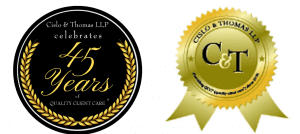Trademark Frequently Asked Questions
How long does a trademark registration last?
A registration has a 10-year term and can be renewed for additional 10-year terms if you prove the mark is still in use for all the goods and/or services stated. Additionally, between the fifth and sixth year anniversary of a mark’s registration, you must file the with the PTO evidence you are still using your mark. If you do not, your registration will be canceled.
What is the difference between the SM, TM, and the R-in-a-circle (®)?
These symbols are all used as notice of trademark rights. Under U.S. trademark law, the R-in-a-circle symbol (®) may only be used in connection with a federally registered trademark. By “federally registered” we mean that the trademark owner filed a trademark registration application with the US Patent & Trademark Office (USPTO) and has been granted a registration. In contrast, the TM and SM symbols, for trademarks and service marks respectively, are often used with marks that have been filed with the USPTO and are awaiting registration or simply to highlight the owner’s claim to exclusive rights.
Do I have to begin using a trademark before I can apply for federal registration?
No. An applicant may apply for federal registration in three principal ways: (1) an applicant who has already commenced using a mark in commerce may file based on that use (an “in-use” application); (2) an applicant who has not yet used the mark may apply based on a bona fide intention to use the mark in commerce (an “intent-to-use” application). The applicant will have to lawfully use the mark in commerce and submit an allegation of use to the Trademark Office before the Trademark Office will register the mark and finally; (3) under certain international agreements, an applicant from outside the United States may file in the United States based on an application or registration in another country.
I live in Canada but I want to protect my trademark in the United States. Can I file for a federal registration?
Yes. Applicants not living in the United States must designate in writing the name and address of a domestic representative – i.e., a person residing in the United States “upon whom notices of process may be served for proceedings affecting the mark.” This person will receive all communications from the USPTO unless the applicant is represented by an attorney in the United States.
How do I know if the mark I want is already taken?
Although not a requirement, an applicant may choose to conduct either a preliminary scan or a full U.S. availability search for conflicting marks prior to applying for registration with the USPTO. As part of the trademark evaluation process, a U.S. trademark examiner will evaluate the efficacy of an application by conducting a search of federally registered marks. If a conflicting mark is found the examiner will notify the applicant. The application fee, which covers processing and search costs, will not be refunded and the mark cannot be registered.
What is the difference between a preliminary scan and full U.S. availability search?
A preliminary scan is a quick, limited search designed to determine if there are any pre-existing identical or very similar marks. Generally a preliminary scan of the U.S. federal register can be accomplished in a few hours by competent trademark counsel.
A full U.S. availability search, on the other hand, will reveal if there are any identical, or similar, pre-existing marks registered at both the federal and state level and existing as “common law.” Common law marks are unregistered marks that are currently being used as domain names, business names, slogans, etc. in commerce. If time permits, it is strongly recommended that a full search be conducted before filing a trademark application and that a written opinion be gathered from a competent trademark attorney on the feasibility of using the mark you pre-selected.
How long does a U.S. trademark application take to grant?
In FY 2020 the average time from filing to first Office Action in a trademark application was 3 months. Average total pendency was 9.5 months for applications that were not opposed or suspended during prosecution.



